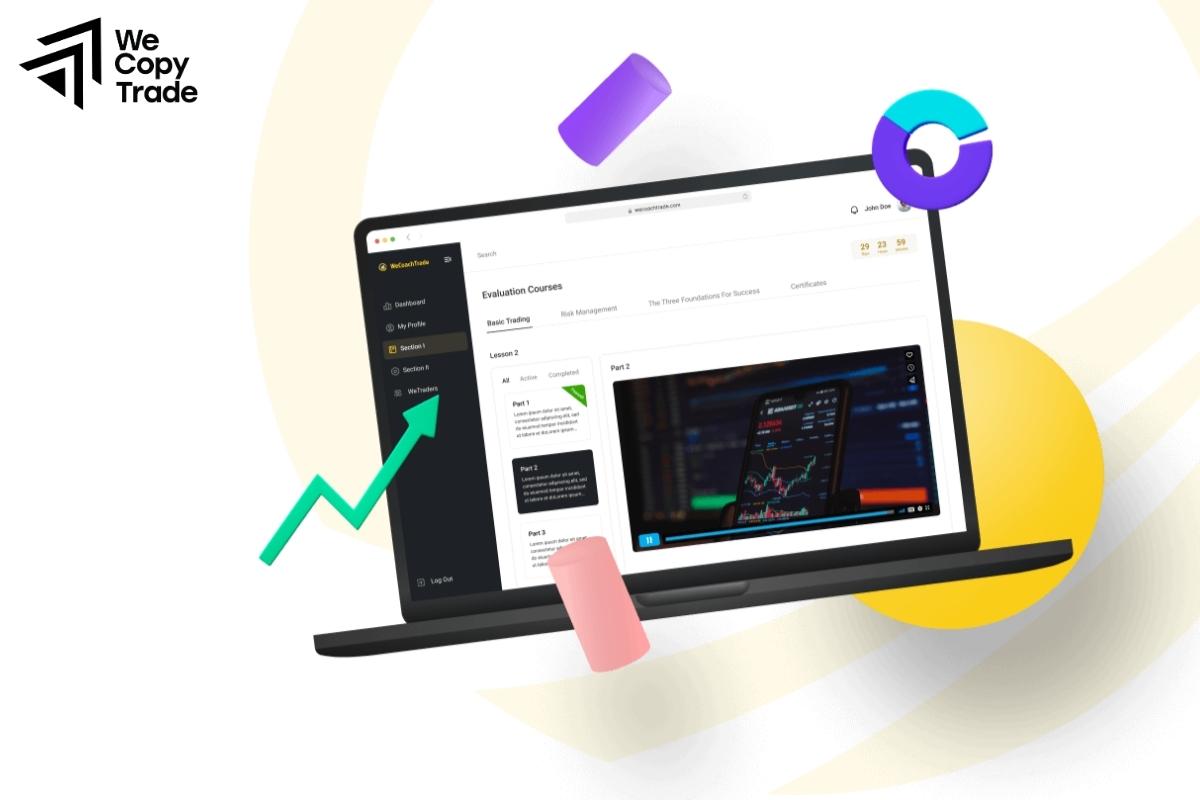
For most traders, becoming consistently profitable takes time, experience, and a lot of trial and error. But what if there was a way to gain exposure to the strategies of successful traders without having to build that expertise yourself? That’s the idea behind copy trading. So, what is copy trading, and how to profit from it? Let’s check it out in this article.
What is Copy Trading?

Copy trading is a relatively new strategy where one trader, called the copier, copies the positions of another trader, referred to as the provider. The copier replicates the provider’s trades, opening identical positions at the same size when the provider opens a position.
The idea behind copy trading is that the copier can benefit from the provider’s experience, skills, and strategies without having to do all the analysis themselves. For the provider, copy trading allows them to potentially generate additional income by allowing others to copy their trades. This gives providers an incentive to develop good trading strategies.
Some copy trading platforms automatically copy the provider’s trades for the copier, while others give the copier some control over which trades to copy. This allows copiers to selectively copy only trades that align with their risk tolerance and preferences.
How does Copy Trading Work?

Understand what is copy trading now? So, how does it wok?
Copy trading allows copiers to automatically or manually replicate the real-time positions of providers they select. The copy trading platform facilitates trade data sharing and alerts between providers and copiers.
The key is that copiers are actually placing independent trades, though aligned with the provider’s positions. The platform simply helps match copiers with potential successful providers and shares the necessary trade information.
Here is the flow of how copy trading work:
- A trader becomes a “provider” by sharing their trades on a copy trading platform. This allows other traders to copy their positions.
- Other traders then become “copiers” and select the provider(s) they wish to copy. They subscribe to receive real-time trade alerts from those providers.
- When the provider opens a new position, they place the trade on their brokerage account as usual.
- The copy trading platform automatically sends a trade alert to all copiers subscribed to that provider.
- The copiers then place identical trades on their own brokerage accounts, copying the provider’s position size.
- As the provider exits or adjusts the position, the copiers are alerted and do the same, maintaining identical positions.
- The copiers thus benefit from any profits the provider makes on that trade, minus any fees charged by the copy trading platform.
- The provider benefits by earning a commission from the platform for each copier replicating their trades. This commission acts as an incentive for the provider to develop good trading strategies.
Pros and Cons of Copy Trading?
While copy trading offers potential benefits, there are risks as well. Copiers are still exposed to all the gains and losses of the positions they copy. Not all providers are successful traders, so copiers must vet potential providers carefully and closely monitor positions.
Pros of Copy Trading

Here are some of the pros of copy trading:
- Access the expertise of successful traders: Copiers can benefit from providers’ experience, skills, and strategies without having to do all the analysis themselves. This is the main attraction of copy trading.
- Potential for high returns: If a provider has a proven successful track record, copiers may achieve similar returns by simply replicating the provider’s trades. Of course, losses would also be similar.
- Lower time commitment: Copy trading may require less time and effort from copiers since they are not researching and placing the trades themselves. They are essentially outsourcing the trading to the provider.
- Income source for providers: Providers can generate additional income by allowing others to copy their trades. This gives them an incentive to develop further and refine their strategies.
- The automation offered by some platforms: Some copy trading platforms automatically copy the provider’s trades for the copier. This reduces the manual effort required by copiers.
- Selectivity: Some platforms allow copiers to copy only some of a provider’s trades selectively. This will enable copiers to filter for trades aligning with their risk tolerance.
- Diversification: Copiers can copy multiple providers to diversify their exposure and reduce provider-specific risks. This makes copy trading a more robust strategy.
Cons of Copy Trading
Here’re some possible risks when choosing copy trading as an investment channel:
- Same risks as the provider: Copiers are still exposed to all the risks and losses of the positions they copy. They take on the same risks as the provider, with no guarantees of success.
- Not all providers are successful: Copiers must carefully vet and monitor potential providers. Just because a trader allows others to copy them does not mean they are a good trader or have a proven track record.
- Lack of transparency: Some copy trading platforms provide little information about providers, making it difficult for copiers to properly evaluate them.
- Fees and commissions: Both copiers and providers typically have to pay fees to the copy trading platform, which reduces their potential profits.
- Delayed trade notifications: There may be a delay between a provider placing a trade and copiers being notified, affecting their ability to enter positions at the same price.
- Reliance on the provider: Copiers rely entirely on the provider’s decisions and strategies. Copiers have no recourse if the provider stops trading or has a string of losses.
- Manual copy trading still requires diligence: Copiers that manually select which trades to copy need to monitor positions and have an exit strategy closely.
- Loss of learning experience: By outsourcing trading to a provider, copiers do not gain experience and learning from researching and placing their own trades.
How to Profit from Others’ Expertise with Copy Trading?
After understanding what is copy trading and how it works, with the proper precautions and due diligence, you can profit significantly from the expertise of others through copy trading. Here’s how to do it:
Step 1: Choose a Copy Trading Platform
Research and compare different platforms to find one that suits your needs. Focusing on key factors like fees, trader selection, the information provided, ease of use, automation, customer support, and reliability, you can identify the copy trading platform that will best help you profit from others’ expertise safely and seamlessly.

WeCopyTrade is one of the best copy trading platforms that you can try out. They offer hands-off, easy-to-use, easy selection, a diverse market, and accurate statistics, which are essential for any copy trader.
Step 2: Create an Account and Connect Your MT4/MT5 Trading Account
Follow the signup process for the selected platform and deposit the capital you want to start copy trading with.
Next, to actually copy trades and benefit from the profits, you must connect your MT4/MT5 brokerage account to the copy trading platform. The platform simply facilitates the copy process by sharing trade signals – you are still responsible for placing the duplicate positions and managing your own risk on your brokerage account.
Step 3: Select a Provider
Browse potential to copy. Go through the list of top masters traders on the platform and filter by criteria like success rate, trading style, risk level, and trading volume.
Perform due diligence on potential providers. Check their historical performance in market conditions, strategy details, risk management process, and trading activity.
Select the providers you want to copy. Start with 1-3 providers to minimize your risk. Consider traders with strategies that align with your own risk tolerance.
Step 4: Config Your Investment

The basis of what is copy trading is implementing your investment like your provider, so it seems to be the most important step. Configure how you want to copy their trades. Choose whether you want to copy all trades automatically or manually select specific ones to follow.
Verify that the provider has placed a trade. Check your copy trading dashboard to ensure the provider has opened a new position.
Place an identical trade on your brokerage account. Enter the same details as the provider’s trade, including asset, type (buy/sell), size, and limit/stop levels. Start with a small proportion of your portfolio, and scale up gradually over time. This limits your downside risk in case the provider has a losing streak.
Monitor the trade closely. Check your dashboard regularly for provider position updates, like partial exits or adjustments. Be ready to exit if the provider’s performance declines. Have a clear exit strategy based on metrics like maximum drawdown or loss percentage.
Step 5: Monitor and Change the Providers
Exit the position when the provider exits or according to your own strategy. Use predefined metrics like maximum loss or drawdown to exit independently of the provider if needed.
Then, you can start to rinse and repeat with other providers. Continue following this process each time the provider opens a new position you want to copy. Adjust your strategy over time based on the provider’s performance and your own preferences.
Read more: How to Copy Trade: Step-by-Step Guides for Beginners
Some Tips for Those Who Want to Start with Copy Trading
With patience and discipline, copy trading can be an excellent way for beginners to gain experience and profits gradually. Here’re some helpful tips which will help you with it:
The Most Important Tip: Deeply Understand What is Copy Trading

A deep understanding of what is copy trading means, realizing that you are still ultimately responsible for your positions. You need a clear strategy, you have to manage risks carefully, and you have to do proper vetting of providers. You can only benefit from others’ expertise without taking on unexpected risks.
The more you understand how copy trading works and what it entails, the better prepared you’ll be to utilize the strategy safely and profitably. So research, ask questions, and develop a plan before copying anybody’s trades.
Top 5 Helpful Tips that You Should Know When Joining Copy Trading:
- Start small and experiment gradually: Only initially risk a small percentage of your portfolio, around 5-10%. Grow progressively over time as you gain experience and confidence. Also, try different providers to see which strategies and styles work best. But, again, start small with each one.
- Choose providers wisely, avoid overly aggressive providers: Only copy traders with a proven track record, transparent strategy, and who match your own risk tolerance. Do thorough due diligence. Look for traders with lower risk and more consistent strategy. Speculative traders may be riskier for beginners.
- Diversify your risk and monitor positions closely: Copy at least 3-5 different providers to spread your risk out. Avoid relying on any single trader, although you have a list of top copy traders. Set predefined exit rules based on metrics like maximum drawdown. Be ready to exit if a provider’s performance declines.
- Keep learning: Consider copying income strategies. Providers focused on generating consistent returns rather than high growth may be more suitable for beginners. Subscribe WeMasterTrade to update the latest copy trading strategies.
- Expect drawdowns and get comfortable losing your capital: Even the best providers will experience occasional losing streaks. Have a plan for handling these periods. Just understand what is copy trading. It, like any other investing channel, always has risks. Copy trading is not a sure thing- only risk money you can afford to lose.
Final Words
Copy trading offers a compelling opportunity for traders to benefit from the expertise of others potentially. But as we have discussed, copiers remain responsible for their portfolio’s risk and performance. Copy trading is not a sure thing – it requires active risk management, proper vetting of providers, and diligence on the part of copiers.
The more you understand what is copy trading, the better prepared you’ll be to utilize this strategy profitably. With patience and discipline, copy trading can potentially enhance your returns – but only if you approach it with open eyes, manage risk carefully and stay involved. Try out copy trading with WeCopyTrade to start your own investment.





